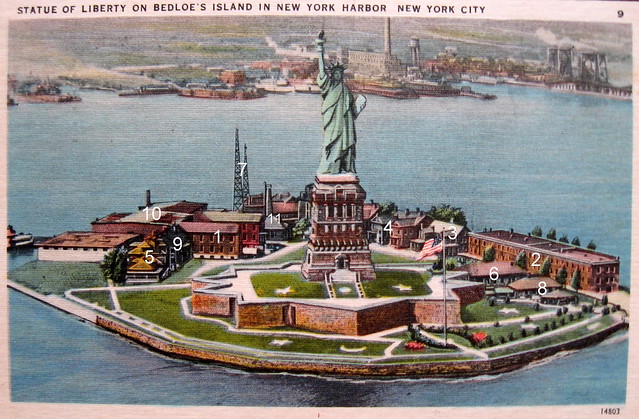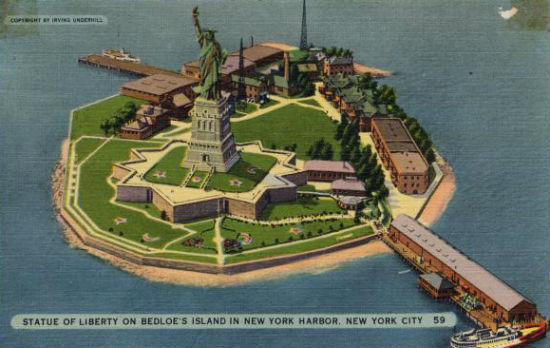
As reported in a book review from the Wall Street Journal, "Beacon Revisited," by Edward Kosner, on 6 June 2012 -- "The too "hearty and well-fed" Lady Liberty, said Mark Twain, didn't reflect the "insults and humiliations" long endured by freedom," by Edward Kosner, on 6 June 2012 -- The Statue of Liberty is a relic—an oxidized icon of a lost age when France and the United States felt they had a special sympathy, and America was proud to be a haven for "tired, huddled masses" of immigrants, few of them from Mexico, Haiti or Bangladesh.
It is now more than 140 years since Belle Epoque sculptor Frédéric Auguste Bartholdi scouted New York Harbor and settled on tiny Bedloe's Island as the site for his Colossus of the New World; more than 125 years since President Grover Cleveland unveiled it; and 25 years since Hollywood impresario David Wolper marshaled 200 Elvis impersonators at the monument's centennial celebration. Thus, the arc of the statue's evolution in the national imagination from august symbol of American liberty to pop-cultural shtick.
The story of the Statue of Liberty has been told many times. Now, Edward Berenson, a professor of history and French studies at New York University, chips in his slender version as part of Yale University Press's Icons of America series. He dutifully covers all the bases in textbooky prose that makes pedestrian seem jaunty.
Lafayette's grandson and de Tocqueville's brother were among the elite Frenchmen who wanted to bestow the statue on the Americans as a reaffirmation of principled liberty, especially in the shadow of the bloody Paris Commune.
Instead of "Marianne," the erotic French spirit of radical liberty with her Phrygian cap and bared belle poitrine, Bartholdi, a momma's boy, designed a matronly lady in a toga holding an upthrust torch, not a revolutionary banner. Gustave Eiffel, in his pre-tower days, did the ingenious armature on which Bartholdi hung 300 wafer-thin copper plates. The approach was a forerunner of curtain-wall architecture. It took the French 13 years to raise the money and construct the statue and years more for the not-especially-grateful Americans to finance, design and erect the pedestal.

The Statue of Liberty; By Edward Berenson
Mark Twain hated it. Lady Liberty looked too "hearty and well-fed" for his taste, reflecting "the insolence of prosperity" rather than the "insults and humiliations" freedom had endured over the ages. Protestant clergymen denounced it as pagan and idolatrous. A Catholic theologian bitterly complained that no Roman goddess should usurp Jesus as the light of the world.
Prof. Berenson's most useful insight is that the statue is a "hollow icon"—so serenely abstract that it sequentially represents whatever the spirit of the times inflicts on it. The monument's centrist French patrons always thought of it as a symbol of orderly American liberty as opposed to the rampages of The Terror and the later Commune. The French also hoped the gift would entice U.S. sympathies back from the Germans, whom the Americans sided with in the humiliating Franco-Prussian War of 1870. The French certainly never conceived of the statue as emblematic of New York, the United States or as a beacon for immigration.

The Statue of Liberty did become a besieged symbol during the tsunami of European immigration that engulfed the East Coast in the first decades of the 20th century, but not in the cuddly way that Americans remember it now. So unpopular was the deluge of unlettered Slavs, Jews, Irish, Italians and Greeks that one American cartoonist depicted Lady Liberty holding her nose as "the dregs of Europe" scuttled over her sandaled feet. Another, captioned "European garbage ships," showed the newcomers being deposited like refuse from vessels anchored on her island. A third—"Come Unto Me, Ye Oppressed"—had a bearded anarchist fiend creeping up behind the statue clutching a bomb and a dagger.
In 1903, O. Henry gave the statue an Irish brogue and had her lament: "I was made by a Dago"—Bartholdi was actually Alsatian—"and presented to the American people on behalf of the French Government for the purpose of welcomin' Irish immigrants into the Dutch city of New York."

Emma Lazarus was, of course, most responsible for the transformation of the statue from a target of nativist revulsion to the New World's elegant welcome wagon. No people's poet, Lazarus was born into a well-established Sephardic Jewish family with no connection to or much empathy for the teeming hordes of the Lower East Side ghetto. She'd been writing poetry since 16, enjoyed a long correspondence with Emerson, and won praise from Turgenev and Whitman.
She didn't think of herself as a Jewish writer, but anti-Semitic incidents in New York and the Russian pogroms of the 1880s moved her, and when asked to contribute to a Bartholdi fundraiser in 1883, she penned a short poem called "The New Colossus" that, as James Russell Lowell wrote her, gave the statue a voice and a rationale. Hardly anyone else at the time noticed, but 20 years later her sonnet ending, "I lift my lamp beside the golden door" was inscribed on a tablet at the entrance to the statue's pedestal.


Even so, as Prof. Berenson points out, it was not for another 30 years, when the tide of immigration all but stopped, that Americans began to think of the statue as a heroic symbol of America's embrace of the world's forlorn. The New Deal pushed the same line. But speaking at the statue's 50th anniversary in 1936, FDR signaled that the golden door had shut. Not many of Hitler's Jewish victims got to sail under the statue's gleaming torch.
The author does a decent job of chronicling the essentials of the Statue of Liberty saga. But he pads his thin book with recitations of every sighting of the monument in movies (including the battle-to-the-death on the torch in Hitchcock's 1942 "Saboteur") and even videogames. There's a tedious account of the travails of the national museum of immigration. And he seems to think "disinterested" means "uninterested." David McCullough has nothing to fear. (source: The Wall Street Journal; Mr. Kosner was the editor of Newsweek, New York, Esquire and the New York Daily News and is the author of a memoir, "It's News to Me." )


No comments:
Post a Comment